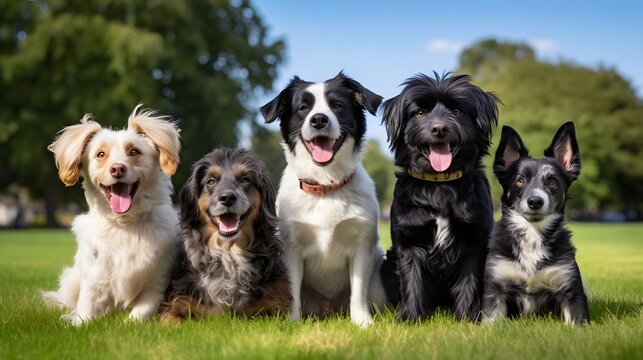Taxonomy and Classification
The domestic dog is scientifically classified as Canis lupus familiaris, a subspecies of the gray wolf (Canis lupus). This classification places dogs within the family Canidae, which also includes foxes and jackals. The binomial nomenclature reflects the dog's evolutionary lineage and its close genetic relationship to wolves.
Domestication and Evolution
Origins
Dogs were the first species to be domesticated by humans, with evidence suggesting this process began over 15,000 years ago. Genetic studies indicate that domestication may have commenced over 25,000 years ago in one or several wolf populations in Europe, the high Arctic, or eastern Asia. The earliest generally accepted dog remains were discovered in Bonn-Oberkassel, Germany, and dated to 14,223 years ago. These ancient dogs were buried with their human companions, suggesting emotional or symbolic ties between humans and dogs. Source
Process of Domestication
The domestication of dogs involved a coevolutionary process where wolves adapted to human environments, leading to changes in behavior and physiology. Early humans likely selected wolves that exhibited less aggression and more sociability, traits that were advantageous for companionship and cooperative hunting. Over generations, these selected wolves evolved into the domestic dogs we know today. Source
Breeds and Diversity
Development of Breeds
Through selective breeding, humans have developed over 400 distinct dog breeds, each tailored for specific tasks or aesthetic preferences. This breeding has resulted in a remarkable diversity in size, shape, and behavior among dogs. For example, Chihuahuas, the smallest recognized dog breed, can be 5 to 8 inches tall at the shoulder, while the Irish Wolfhound, the tallest dog breed, can be 30 inches or more. Source
Breed Groups
Dog breeds are often categorized into groups based on their original functions:
- –
Sporting Group: Bred to assist hunters in capturing and retrieving game. Examples include Labrador Retrievers and Spaniels.
- –
Working Group: Developed for tasks such as guarding property, pulling sleds, and performing rescues. Examples include Siberian Huskies and Boxers.
- –
Herding Group: Bred to herd livestock. Examples include Border Collies and German Shepherds.
- –
Toy Group: Bred primarily for companionship. Examples include Pomeranians and Pugs.
- –
Non-Sporting Group: A diverse group with varied backgrounds and purposes. Examples include Dalmatians and Poodles.
Source
Behavior and Intelligence
Communication
Dogs communicate through a combination of vocalizations, body language, and facial expressions. Common forms of communication include barking, growling, whining, and howling. Body postures, such as tail wagging or ear positioning, convey emotions and intentions. Eye contact and facial expressions also play significant roles in canine communication. Source
Cognitive Abilities
Studies have demonstrated that dogs possess notable cognitive abilities. For instance, a Border Collie named Rico was shown to understand over 200 words and could infer the names of novel items by exclusion learning. Another Border Collie, Chaser, learned the names of over 1,000 objects. These examples highlight the advanced learning capabilities and problem-solving skills present in some dogs. Source
Roles in Human Society
Companionship
Dogs have been companions to humans for thousands of years, providing emotional support and companionship. Their loyalty and affectionate nature have made them one of the most popular pets worldwide. In the United States, nearly 40% of households own at least one dog. Source
Working Roles
Beyond companionship, dogs serve in various working roles:
- –
Service Dogs: Assist individuals with disabilities, such as guide dogs for the visually impaired.
- –
Therapy Dogs: Provide emotional support in settings like hospitals and nursing homes.
- –
Search and Rescue Dogs: Trained to locate missing persons in various environments.
- –
Police and Military Dogs: Employed for tasks including detecting explosives and apprehending suspects.
Source
Health Benefits
Interacting with dogs has been associated with various health benefits for humans, including reduced stress levels, increased physical activity, and decreased feelings of loneliness. Studies have shown that dog owners often have lower blood pressure and cholesterol levels compared to non-owners. Source
Cultural Significance
Throughout history, dogs have held significant cultural and symbolic roles:
- –
Ancient Egypt: Dogs were associated with Anubis, the god of the afterlife, depicted with a canine head.
- –
Mesopotamia: Dogs appeared in cuneiform tablets, guarding grain stores and flocks.
- –
China: Jade carvings depict small companion dogs believed to offer protection and good fortune.
Source
In modern times, dogs continue to influence culture, appearing in literature, art, and media, symbolizing loyalty, protection, and companionship.
Health and Lifespan
Common Health Issues
Dogs are susceptible to various health conditions, including:
- –
Obesity: Can lead to joint problems, diabetes, and decreased lifespan.
- –
Dental Diseases: Such as periodontal disease, affecting overall health.
- –
Parasites: Including fleas, ticks, and worms, which can cause various health issues.
Source
Lifespan
The lifespan of a dog varies by breed and size. On average, dogs live between 10 to 13 years. Smaller breeds often live longer than larger breeds. Factors such as genetics, diet, and healthcare significantly influence a dog's longevity. Source
Conclusion
The domestic dog has played an integral role in human history and continues to be a vital part of many people's lives. From their origins as domesticated wolves to their current status as beloved companions and working animals, dogs exemplify the deep bond between humans and animals. Their diversity in breeds, behaviors, and roles underscores their adaptability and enduring significance in human society.
